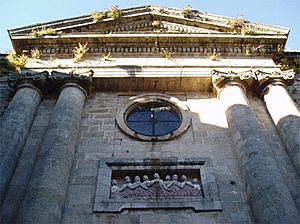Capela de Ánimas facts for kids
Quick facts for kids Capela de Ánimas |
|
|---|---|

Upper part of the facade.
|
|
| Religion | |
| Affiliation | Roman Catholic |
| Ecclesiastical or organizational status | Chapel |
| Location | |
| Location | Santiago de Compostela, Galicia, Spain |
| Architecture | |
| Architect(s) | Miguel Ferro Caaveiro |
| Architectural style | Neoclassical |
| Completed | 1788 |
The Capela de Ánimas is a special chapel located in Santiago de Compostela, a city in Galicia, Spain. Its name means "Chapel of Souls." Building this chapel began in April 1784. An architect named Miguel Ferro Caaveiro designed it. The construction was finished in 1788.
Contents
What the Chapel Looks Like
The Capela de Ánimas has one main room, called a nave. This room has a curved ceiling, like a half-cylinder, known as a barrel vault. On each side of the main room, there are three smaller chapels. These side chapels are connected to each other.
Main Altar Area
At the front of the chapel is the main altar area, called the presbytery. It has a rectangular main chapel, which is a bit narrower than the main room.
Outside Design
The front of the chapel, called the frontispiece, is very grand. It has two pairs of large columns. These columns are smooth and have a special top design called Ionic style. They stand on tall bases. These columns hold up a flat structure called an entablature. On top of this, there is a straight triangular shape known as a pediment. Two angels are placed on top of the pediment, looking towards a Cross.
Inside Decorations
Inside the chapel, the side chapels are decorated with painted bas-reliefs. These are sculptures that stick out slightly from the wall. They show scenes from the Passion of Christ. This includes moments like the Flagellation of Christ (when Jesus was whipped) and the crucifixion. They also show the resurrection of Jesus, when he came back to life. These scenes are part of the Way of Sorrows.
Front Door Relief
Above the main door on the outside, there is another relief sculpture. This sculpture shows nine people who appear to be burning. This image is meant to represent the "Souls of Purgatory." In some Christian beliefs, Purgatory is a place where souls go to be purified before going to heaven.
See also
 In Spanish: Capilla de Ánimas para niños
In Spanish: Capilla de Ánimas para niños

